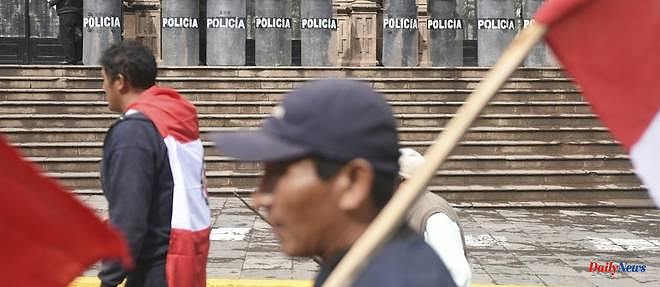Advancing meter by meter, barefoot in the black earth, Ruben Gutierrez Escobar, 63, bent back, plows his cornfield with a hoe. We are in Bella Vista, near Cuzco in southern Peru, 3,500 meters above sea level in the Andes. No tractor, no fertilizers. Only "sweat, work and sacrifice".
"Lima completely forgets about us," he says.
The unrest in Peru, which has claimed 48 lives since December, also reflects the huge gap between the capital Lima and the Andes, where the vast majority of protesters who are calling for the resignation of the president and new elections.
The crisis began after the dismissal and arrest on December 7 of left-wing President Pedro Castillo, of Amerindian and Andean origin, accused of having attempted a coup d'etat in order to dissolve the Parliament which was about to oust him. power. Vice-President Dina Boluarte then replaced him.
Ruben is part of this poor Peru "forgotten from Lima". He gets up at 3 am to look after his five cows and seven sheep, then works in the field until sunset, cultivating potatoes, beans and maize for his household consumption. He goes to bed around 10 p.m.
He earns 20 or 25 soles (about 6 dollars) a day by selling "5 or 10 small liters of milk". "We lack everything. It brings in almost nothing. We never have a good harvest to live well".
Gold, copper, silver, zinc mines... Tourists visiting the Inca marvels and in particular the nearby Machu Picchu... Most of Peru's wealth is however in the Andes and like many demonstrators, Ruben asks: "We are talking about royalties from the mines (to the State), where does it go? All the money coming in goes to Lima, and in Lima, it gets lost. Here, we don't get a penny," he said.
“We have no state support,” he complains. He emphasizes that no agricultural engineer or veterinary service has ever helped him despite the requests. He no longer uses fertilizers, which are not subsidized, since the price was multiplied by six because of the war in Ukraine.
He protests against the weakness of infrastructure, health and education services. "They say the hospital is free. It's not true. 100% lie. You have to pay with your money," he says.
Above all, he regrets not having given an "education" and a job to "at least one" of his three sons: "it was not within my means, because here in the countryside we have nothing".
"People say to themselves: How is it that we exploit the gas (near Cuzco) and we don't have any gas? How is it that having all the mines, we don't have good schools and good hospitals?" explains anthropologist Julio Edmundo Oliveira, a graduate of the University of Cuzco.
"It's a structural problem. It's not new. It's not the fault of Pedro Castillo or Dina Boluarte", he assures us, attributing the "problem to the poor training of the 'State".
"Cuzco - capital of the Incas - developed with the culture of the Andes. Since independence in 1821, the Peruvian Republic (...) has developed with a centralism of Lima", he estimates, assuring : "The Republic and the centralism of Lima have not taken care of education in Peru. The government has never sought to install good schools or high schools" in the provinces.
"We have never invested in the Andes when the Andes maintain the capital," he says.
The anthropologist takes the example of Cerro de Pasco, a complex of several mines at the end of their life in the Andes, 250 km northeast of Lima and 4,200 m above sea level. "People have lead in their lungs but there are no hospitals, high schools or good universities. They took all the ore and left a hole. Cerro de Pasco is one of the poorest departments of the country. A shame", he protests.
In the Angostura district of Cusco, Ruben Mina, 53, a taxi driver, has just lined up unsuccessfully to get a bottle of gas. The city's blockade by protesters has created shortages, but it stands against the president and parliament.
"Boluarte thinks that the majority of the people are ignorant. Especially those from the mountains. That's enough, the inequalities, this abusive centralism!" he gets angry. “There is a country called Lima and another country which is Peru. Corruption has been allowed to become institutionalized”.
Tupac Amaru Square in Cuzco, at the foot of the imposing black statue of the Inca leader who fought against the Spaniards, demonstrators waving Peruvian but also Andean flags chant: "We are of Inca blood, we are not terrorists "
The power and the elites of Lima often qualify the demonstrators as "terrorists" because of the violence, but also in an allusion to the Shining Path or Tupac Amaru groups, which claimed Amerindian origins.
"Yes, we are of Inca blood. We, the Quechua nation, are the heirs of the Andean resistance of the colonial era", explains one of the demonstrators, Javier Cusimayta Osca, teacher.
"It's the resistance of our Quechua, Aymara (Puno ethnic group) or Amazonian peoples. All united! We are accused of being terrorists but we are not. We are humble and dignified", he adds .
"Obviously there is a contempt for Lima. There is a strong centralism like in the colonial era. They want us to believe that Lima is Peru. But it is a part of Peru in the same way than Cuzco, Madre Dios (southeast) or another region", he adds, concluding in Quechua "Hoq Saqmalla! Hoq Kallpalla! Hoq Sonqolla!": "One fist! One strength! One Heart!"
05/02/2023 12:48:42 - Cuzco (Pérou) (AFP) - © 2023 AFP












